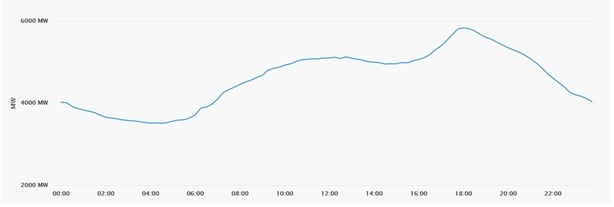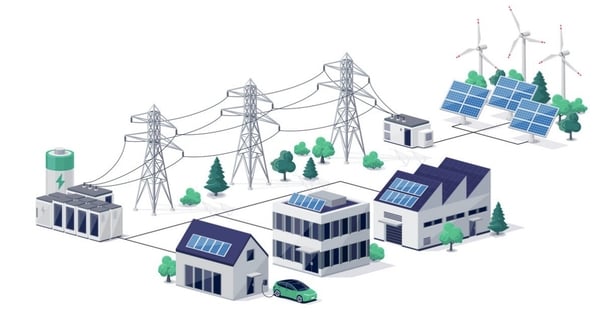Analysis: here we will consider what Virtual Power Plants are, how they work, and what this could mean for you as a consumer
Virtual Power Plants (VPPs) are essential if we are to diversify our grid and maintain reliability. Here we will consider what they are, how they work, and what this could mean for you as a consumer. But to understand how a virtual power plant works, we must first understand how the different types of plants currently used within our grid operate. A traditional power plant operates by boiling a liquid and using the resultant pressurised gas to spin a turbine. This relatively simple concept underpins the vast majority of electricity generation globally.
Coal, gas and even nuclear energy plants operate in this manner with the main differences between each being the fuel that they use to generate heat. These methods have various advantages and disadvantages related to environmental damage, cost to build, cost to operate and how quickly they can respond to a demand for electricity production.
How quickly a power plant can respond is important for the reliability of our national grid because how much energy we use varies widely throughout the day. You can find real-time data for Ireland and look at how this curve changes over the seasons through the EirGrid website. Power plants that respond slowly are typically used as 'base load' plants, and these include coal and nuclear plants.
We need your consent to load this rte-player contentWe use rte-player to manage extra content that can set cookies on your device and collect data about your activity. Please review their details and accept them to load the content.Manage Preferences
From RTÉ Radio 1's Morning Ireland, Celtic Interconnector to link Ireland's electricity grid to France
These plants can produce a lot of electricity, but they do not respond well when asked to increase or decrease supply quickly. This is why they usually produce a consistent amount of electricity each day, all year long, unless they are occasionally shut down for maintenance.
But what happens when everyone comes home from work at 5 pm, when 100,000+ kettles are boiled, washing machines run and ovens are turned on? As you can see from our graph, there is a big jump in demand. Base load coal or nuclear plants can’t respond to this type of urgent demand so we must rely on a different type of quick response solution. These are often referred to as ‘peaker plants’ and are usually gas-powered. These plants might not produce a lot, or any, electricity for much of the day. But when needed they can quickly ramp up and fill that peak demand we see each evening.

In many parts of the world, we are now seeing an increase in energy storage options that can meet this peak need without the environmental damage associated with gas plants. In Ireland, we have the Ardnacrusha hydroelectric power plant and newer storage systems that are also helping to meet these high-demand periods.
This ability to store energy at a large scale is key to maintaining reliability as we transition to a renewable-based grid. Although we have some of the most reliable wind patterns in the world, there will be periods when wind energy production is lower. The same can happen for solar. In these instances, we need to be able to turn to stored energy, but also we need to be able to store energy when it is not needed. For example at 3am when most of the country is asleep we see a large drop in demand. This is reflected in variable pricing deals from suppliers who offer better value at off-peak times.

In response to increased costs, both financial and environmental, we have also seen many homeowners become energy producers. We are currently installing a considerable amount of energy production and energy storage in homes all over the country. Adding to this we are now seeing EVs come to market that can further support energy storage and supply for the home. But having 10,000+ micro power producers requires a sophisticated system that can predict demand, coordinate energy requests and financially reward homeowners who contribute to energy.
It must do all this while considering existing large-scale energy supply and demand. This requires an coordinated approach often referred to as a Virtual Power Plant. A virtual power plant doesn't have a big central industrial site where it produces energy. Instead, it can use advanced technology to call on 1000+ different sources of energy to meet demand. This can include your small battery installation, or even through an interconnector from as far away as France.
We need your consent to load this rte-player contentWe use rte-player to manage extra content that can set cookies on your device and collect data about your activity. Please review their details and accept them to load the content.Manage Preferences
From RTÉ Archives, a news 1963 RTÉ News report on peak demands on the hydroelectric power station at Ardnacrusha
It can achieve this using an enormous amount of data relating to available energy at each location and real-time demand. Future systems will be able to improve the efficiency of our grid by drawing on local power sources, including residential, and reduce the need for long-distance movement of electrical energy.
This is ultimately good for us, the consumers. By supporting a decentralised grid we increase reliability, but we also reduce the risk of one supplier of a particular type of energy being able to exert control or inflict damage. In recent years we have become acutely aware of our over-reliance on gas and the power that this afforded Russia. By diversifying we can reduce the risk of further price shocks while ensuring our energy independence.
Read More: How electric cars can power your home and save you money
At the foundation of our state, we recognised the need to secure our energy independence when we undertook one of the largest infrastructure projects the country has ever seen, Ardnacrusha. Although Ireland has changed immeasurably since then, we again need to look to energy security with the same ambition and determination.
The views expressed here are those of the author and do not represent or reflect the views of RTÉ









